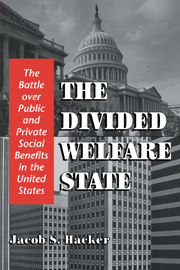Book contents
- Frontmatter
- Contents
- List of Tables
- List of Figures
- Preface
- Part I The American Welfare Regime
- Part II The Politics of Public and Private Pensions
- Part III The Politics of Public and Private Health Insurance
- Introduction
- 4 Seeds of Exceptionalism: Public and Private Health Insurance Before 1945
- 5 The Elusive Cure: Public and Private Health Insurance After 1945
- Part IV The Formation and Future of the American Welfare Regime
- Appendix
- Notes
- Index
4 - Seeds of Exceptionalism: Public and Private Health Insurance Before 1945
Published online by Cambridge University Press: 05 June 2012
- Frontmatter
- Contents
- List of Tables
- List of Figures
- Preface
- Part I The American Welfare Regime
- Part II The Politics of Public and Private Pensions
- Part III The Politics of Public and Private Health Insurance
- Introduction
- 4 Seeds of Exceptionalism: Public and Private Health Insurance Before 1945
- 5 The Elusive Cure: Public and Private Health Insurance After 1945
- Part IV The Formation and Future of the American Welfare Regime
- Appendix
- Notes
- Index
Summary
In the United States, neither public nor private health insurance had any substantial presence before the twentieth century. The federal government ran only one true health insurance program: the U.S. Marine Hospital Service, established in 1789. By political default as well as accepted constitutional understanding, state governments were charged with the task of regulating health insurance. But there was little to regulate and even less political inclination to do so. At the dawn of the twentieth century, the principal source of “sickness insurance” was mutual aid organizations, which devoted only a small portion of their modest funds to medical protection. Less cohesive and politically engaged than their European counterparts, U.S. fraternal organizations were also, it appears, less involved in sickness insurance – then the stock-in-trade of European associations, especially Britain's extensive network of friendly societies.
American fraternals were not alone in their reluctance to address medical needs. Among other potential sources of private health security – trade unions, employers, commercial insurers – none provided more than token protection or reached more than isolated pockets of American workers. Instead, it was life insurance and its poorer cousin “industrial insurance” that dominated the American imagination and market. Sold by armies of agents as protection against a pauper's burial, industrial insurance was at once insufficient and inefficient, with less than a third of total receipts paid out as benefits.
- Type
- Chapter
- Information
- The Divided Welfare StateThe Battle over Public and Private Social Benefits in the United States, pp. 191 - 220Publisher: Cambridge University PressPrint publication year: 2002

